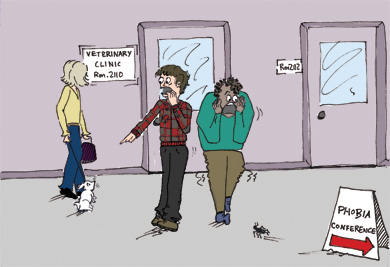
The life of an ancraophobe would be nearly impossible at Queen’s. I don’t know any personally, but perhaps this is because ancraophobia is the fear of wind, and Kingston happens to be one of the windiest cities in Canada.
Now, you may find yourself questioning the validity of such a fear. Wind, really? What could have caused such a bizarre phobia? A freak wind accident? An overly intense day of sailing on the family yacht?
While the possible sources are endless and it may seem irrational, fear of wind is just one of hundreds of psychologically recognized phobias.
The American Psychiatric Institute for Research and Education reported that over 7.8 per cent of adults in North America have a phobia. In fact, they are the most common psychiatric illness among women of all ages and the second most common among men over 25. This means roughly two million Canadians, or 1,400 Queen’s Students have a phobia. I am one of those 1,400.
Although I can stand up to wind like no other, I’m terrified of snakes.
According to Dr. Kate Harkness, an associate professor of the psychology department at Queen’s, having a fear is completely normal and often linked to one’s personality or psychological temperament.
“Some people are born with a general tendency to be more fearful or anxious than others,” she said.
Although I don’t consider myself an anxious person by any means, I have always shied away from serpents. Harkness said this could be due to a primitive awareness of snakes as potentially harmful.
“As a species, [we] may be genetically programmed by evolution to fear certain things that were dangerous to our ancestors,” she said.
Although it is unlikely that I will ever come face to face with a cobra or a boa constrictor, my fear could potentially be a genetic one.
Apparently I am in good company—Harkness said some of the most common phobias are snakes, spiders, enclosed spaces and heights.
Although many phobias are completely inexplicable, some—such as a fear of drowning—can stem from actual events in a person’s life.
Alex Steele, ArtSci ’11, described the makings of his childhood phobia.
“A few years ago, I got stuck in an elevator during a fire drill in my parents’ apartment building,” he said. “I was about 12, but it was the scariest thing that has ever happened to me. Being able to hear the fire alarm outside, and knowing that no one knew I was stuck inside. The experience lasted about half an hour, but I have never and will never step inside an elevator again. I just can’t do it.” In the case of the rational or the irrational, the treatment for a phobia is the same: a process called Gradual Exposure Therapy. GET, Harkness explained, essentially puts into practice the age-old concept of facing one’s fears. “In this type of treatment, the client and the therapist create a list of increasingly fearful situations, which are gradually confronted over the course of the treatment,” she said. “Over time, exposure diminishes the fear response, allowing the person to instead associate the feared stimulus with safety and relaxation.” But for many, phobias hold an odd attraction.
Indeed, the concept of fear is so captivating it has become a business in and of itself. Horror or “thriller” films, such as Jaws, Pyscho and Frankenstein have been some of the highest grossing movies of all time.
In most cases, the standard scary movie thrills viewers by fooling the body’s natural reaction to stressful situations, in the form of an adrenalin rush. This rush releases endorphins in the body, which are responsible for the feeling of well being and relief of pain. Endorphins affect the body similarly to opiates and are released into the body after moderate exercise, a long cry or an orgasm.
Even in television, shows such as Fear Factor—which challenges people to sit in pits filled with snakes, jump across buildings and digest creepy-crawlies to test contestants’ personal limits—attract our interests for similar reasons.
In syndication now, the show provided five years of primetime television entertainment and serves as a perfect example of society’s pseudo-masochistic interest in their own fears and the fears of others. Shows such as Fear Factor reveal our culture’s tendency to magnify frightening situations for entertainment value. They also demonstrate the theory that many fears are socially constructed. A study at Northwestern University discovered that monkeys could easily be taught to fear snakes—even if the monkey in question had never seen a snake—simply by showing that monkey a video of another monkey acting fearfully when confronted with a snake.
In an eerily similar example, beach attendance in the state of California was at an all time low in the summer of 1975, the summer of Jaws’ record-breaking release.
It would seem, when it comes to fright, that we’re not far removed from our simian ancestors.
All final editorial decisions are made by the Editor(s)-in-Chief and/or the Managing Editor. Authors should not be contacted, targeted, or harassed under any circumstances. If you have any grievances with this article, please direct your comments to journal_editors@ams.queensu.ca.
